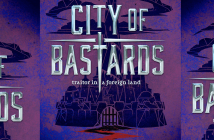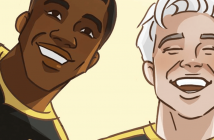I tried really hard to write a book about someone else. It started as my grandmother. It was supposed to be her story, based on the wild events from her own life. I realized pretty quickly that I needed a character from a generation and time that I’d actually lived myself—and so I gave the grandmother in the book a teenage daughter. That girl wasn’t me. She was the shadow of a person; I couldn’t even see her outline clearly enough to know where I might be coloring outside the lines.
I wrote, and wrote, and rewrote. And rewrote some more. I scrapped whole drafts and rewrote them from scratch. You could argue I wasn’t even writing the same book anymore. New cast of characters. New plot points. New beginnings, and new endings. I wrote until I couldn’t help it: Pieces of myself began to worm their way out of me and onto the page.
I used to think that when I wrote fiction, I was just building myself a sandbox to play in. It took me a long time to realize that the sandbox for this book had been there all along, that it was shaped from my life, from my aches and wants, my love and my rage.
The pieces of myself that pressed their way out of my fingers drew the shape of Leigh Chen Sanders. They sculpted themselves, made her real, gave her legs—and from there I simply followed where she went.
Leigh’s not exactly me, but we have a lot in common. Growing up, I lived in mostly-white communities. There were constant reminders that I looked different. I brought lunches to school that my peers found strange. And having immigrant parents meant that I didn’t know the right radio station to listen to, or the right television channels to watch.
I learned to take pride in being weird and different. But the times that different really stung were the few chances I got to interact with my Asian peers—because I didn’t fit in with them either. It seemed that either they felt I was “too white” (literally a term that I have heard again and again), or the opposite: They’d so deeply absorbed the culture of their own white friends that they seemed to be even more American than me.
Did you catch what I said up there? Up until college I literally thought of the things I did and felt as being either more American or less American. I had to look in the mirror and sternly say: Stop constantly othering yourself.
Leigh is biracial, which I’m not, but she straddles the two worlds of her identity in a very similar way.
That’s really the shape the sandbox takes for The Astonishing Color of After. It’s a giant question of identity.
So I’ve talked about the part of your identity that you’re born with, but then there are the parts that you choose for yourself.
As a teen I was also an intense musician who counted the days by my orchestra and choir rehearsals. I dreamed of going to a conservatory to study composition. I also spent most of my free time (defined as time not doing homework or practicing music) writing fiction. My parents encouraged these hobbies…and simultaneously discouraged me from pursuing them professionally.
I gave this same passion and struggle to Leigh with her visual art. (I like to sketch and paint myself, but Leigh’s a much better artist than I’ll ever be.)
 Leigh knows she loves making art more than anything else, and one thing she wants to do is prove to herself that she’s able to build the discipline and stamina to pursue it professionally. I guess that was something I wanted to leave in the book like a message in a bottle, for the readers out there who are just like teenage-me. For the people who so want to live a creative life, and pursue that professionally, but are asking themselves if they’ve got what it takes.
Leigh knows she loves making art more than anything else, and one thing she wants to do is prove to herself that she’s able to build the discipline and stamina to pursue it professionally. I guess that was something I wanted to leave in the book like a message in a bottle, for the readers out there who are just like teenage-me. For the people who so want to live a creative life, and pursue that professionally, but are asking themselves if they’ve got what it takes.
Here’s the message: You’ve got what it takes. You just have to do it.
These are only a few examples of how I dug into myself to find Leigh. But the crucial thing is that I had to let the pieces of me come out onto the page in order to figure out what I actually wanted to say. Above, I said that I left that message in the book for readers—but first I wrote it for me. This book was my proof to myself that I’ve got what it takes. How fitting that Leigh and I journeyed together to reach that.




